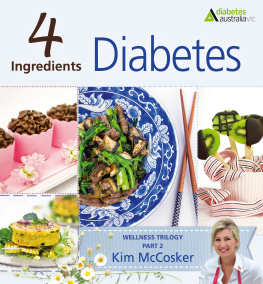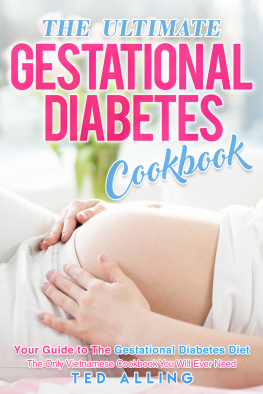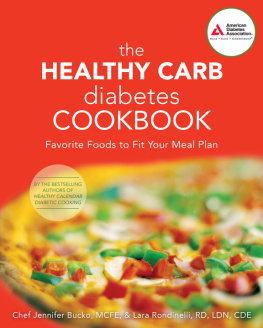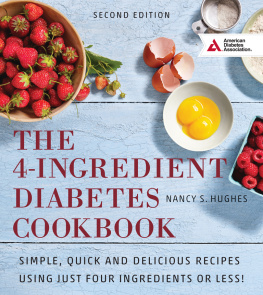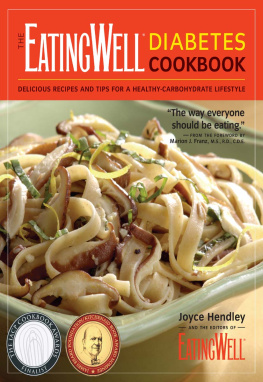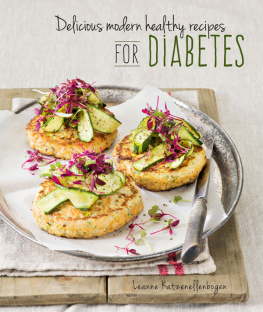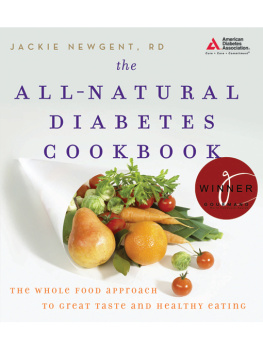Diabetes Australia. - 4 ingredients, Diabetes
Here you can read online Diabetes Australia. - 4 ingredients, Diabetes full text of the book (entire story) in english for free. Download pdf and epub, get meaning, cover and reviews about this ebook. City: Mooloolaba;Qld, year: 2013, publisher: 4 Ingredients, genre: Home and family. Description of the work, (preface) as well as reviews are available. Best literature library LitArk.com created for fans of good reading and offers a wide selection of genres:
Romance novel
Science fiction
Adventure
Detective
Science
History
Home and family
Prose
Art
Politics
Computer
Non-fiction
Religion
Business
Children
Humor
Choose a favorite category and find really read worthwhile books. Enjoy immersion in the world of imagination, feel the emotions of the characters or learn something new for yourself, make an fascinating discovery.
- Book:4 ingredients, Diabetes
- Author:
- Publisher:4 Ingredients
- Genre:
- Year:2013
- City:Mooloolaba;Qld
- Rating:4 / 5
- Favourites:Add to favourites
- Your mark:
- 80
- 1
- 2
- 3
- 4
- 5
4 ingredients, Diabetes: summary, description and annotation
We offer to read an annotation, description, summary or preface (depends on what the author of the book "4 ingredients, Diabetes" wrote himself). If you haven't found the necessary information about the book — write in the comments, we will try to find it.
4 ingredients, Diabetes — read online for free the complete book (whole text) full work
Below is the text of the book, divided by pages. System saving the place of the last page read, allows you to conveniently read the book "4 ingredients, Diabetes" online for free, without having to search again every time where you left off. Put a bookmark, and you can go to the page where you finished reading at any time.
Font size:
Interval:
Bookmark:
I enjoy people . I love to engage with, talk with and listen to people. By nature I ask many questions, as my greatest learnings come from everyday, busy people just like me. And it's often where the best ideas for future books and projects stem from people just like you.
This is exactly how the Wellness Trilogy came to be. From conversations on our Facebook page, emails to info@4ingredients.com.au and your interest at my public engagements, the most frequently asked questions are; when are you bringing out a 4 Ingredients book relating to Gluten, Lactose, Diabetes and Allergies? So for you all Here they are!
Three beautiful, affordable books each with over 60 quick, easy and delicious recipes aimed to encourage us all; not only to eat better, but to prevent Prevention is the best Medicine!
Watch for Wellness Tips  throughout the trilogy.
throughout the trilogy.

Growing up, I was the sibling of someone with type 1 diabetes and was recently referred to as a Type 3 Diabetic.
No! I dont have diabetes, nor did my parents or one brother, but we were all affected by it. I was 10 at the time and had never even heard of diabetes; let alone knew what a pancreas did? My family and I learnt to inject insulin on an orange and what to do in the event my youngest brother had a hypo and his diagnosis completely changed our daily eating and drinking habits for the better.
I wrote this cookbook for my brother Boo-Boo.
He was diagnosed in 1980, with type 1 diabetes aged 2. He has never let having diabetes stop him from doing anything he wanted to do.
This book is for the Boo-Boos of the world, who simply get on with life as if its a gift, to be lived to the fullest.
With Love & Admiration
Kim

Diabetes is a condition where there is too much GLUCOSE in the bloodstream. This may be because the pancreas is no longer producing insulin, not producing enough insulin or the insulin produced is not working properly.
Glucose is the primary source of energy for the body, and is produced when foods containing carbohydrate are digested and broken down in the stomach and small intestine.
What is Insulin?
Typically, our pancreas regulates the glucose levels in our bloodstream by producing a hormone called INSULIN . Heres how it works; when we eat, food goes to the stomach and the small intestines. There it is digested or broken down into nutrients that are small enough to be absorbed into the bloodstream.
Our bodies can get energy from three main nutrients:
Carbohydrates (such as those in bread, potatoes and fruit) are broken down into glucose.
Proteins (in foods such as meat and cheese) are converted into amino acids and form the building blocks of our body.
Fats including butter, margarines and oils, turn into fatty acids, and are used for the absorption of certain vitamins and also as a long term energy storage.
However, glucose is the bodys preferred source of energy, for two reasons:
It can be converted quickly into energy when we need it, such as during work or sports.
The brain and nerves rely on a constant supply of glucose to function.
When glucose enters the bloodstream, the pancreas responds by releasing insulin into the blood, which then allows the glucose to be absorbed by the cells and used as energy.
Type 1
When someone has type 1 diabetes, the pancreas stops producing insulin altogether. Because of this, insulin injections are needed in order to survive. Type 1 diabetes is an autoimmune condition and cannot be prevented. It is usually diagnosed in childhood or the teenage years, however, more and more people are now being diagnosed later in life.
Type 2
When someone develops type 2 diabetes, the pancreas is still producing insulin, however, it may not be producing enough and / or it may not be working properly. Type 2 diabetes can often be managed with a healthy, balanced diet and regular physical activity, though tablets and insulin are sometimes required.
Although having a family history of type 2 diabetes can be a major risk factor for the development of this condition, the risk is greatly increased by being overweight or obese (especially around the waist area), having a poor diet, insufficient physical activity, and other factors such as having high blood pressure and high levels of fat in the blood (cholesterol and triglycerides).
Gestational (jes-tay-shon-al) Diabetes
Occurs in some women during pregnancy, as the hormones that are produced during pregnancy can make it harder for the insulin to work. It is diagnosed when higher than normal blood glucose levels first appear during pregnancy. Between 5% to 8% of pregnant women will develop gestational diabetes and this usually occurs around the 24th to 28th week of pregnancy. Gestational diabetes usually goes away after the baby is born, however, it increases the risk of developing type 2 diabetes in the future.
280 Australians develop diabetes every single day
Type 2 diabetes represents approximately 85-90% of all cases
The astounding statistic is that approximately 60% of type 2 cases can be prevented .
It is reported that 1 in 4 Australians are affected by diabetes , combining those with type 1, type 2, gestational and pre-diabetes.
Pre-Diabetes
Pre-diabetes is a condition when blood glucose levels are higher than normal but not yet high enough for a diagnosis of type 2 diabetes.
An estimated 2 million Australians have pre-diabetes.
According to Craig Bennett , Diabetes Australia Vic Chief Executive Officer: Diabetes is the fastest growing chronic disease in Australia and the prevalence of all types of diabetes type 1, type 2 and gestational diabetes is increasing.
Symptoms
For many people diagnosed with type 2 diabetes, symptoms may go unnoticed until the condition has progressed. Diabetes Australia Vic state Most people with type 1 diabetes and many with type 2 diabetes will present with symptoms of diabetes such as; increased thirst, urination and tiredness. Some people will also have signs of slow healing of wounds or persistent infections. However many people with type 2 diabetes have no symptoms at all.
Routine physical exams can identify and diagnose diabetes before the condition progresses further. Diabetes is diagnosed by a blood test to measure the levels of glucose in your blood stream. High levels of glucose indicate that either type 1 or type 2 diabetes is present. Sometimes, it is difficult to determine what type of diabetes is present and further blood tests may need to be done. For more detailed information, please see www.diabetesvic.org.au .
The aim of treatment for people with diabetes is to manage blood glucose levels (BGLs), and reduce the risk of developing long-term complications such as eye and kidney problems, coronary heart disease (CHD) and nerve damage.
It is important to note that there is no special diet for people with diabetes. Healthy eating is the same for all people, and we should all aim to limit foods that are high in saturated fats, added sugars and sodium (salt) and increase intake of unprocessed and high fibre foods such wholegrain breads and cereals, legumes, fresh fruit and vegetables, low-fat dairy products and lean sources of protein foods such as red meats, skinless chicken, fish and eggs.
Font size:
Interval:
Bookmark:
Similar books «4 ingredients, Diabetes»
Look at similar books to 4 ingredients, Diabetes. We have selected literature similar in name and meaning in the hope of providing readers with more options to find new, interesting, not yet read works.
Discussion, reviews of the book 4 ingredients, Diabetes and just readers' own opinions. Leave your comments, write what you think about the work, its meaning or the main characters. Specify what exactly you liked and what you didn't like, and why you think so.

